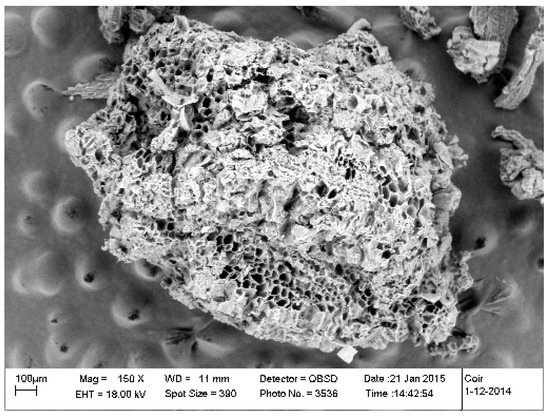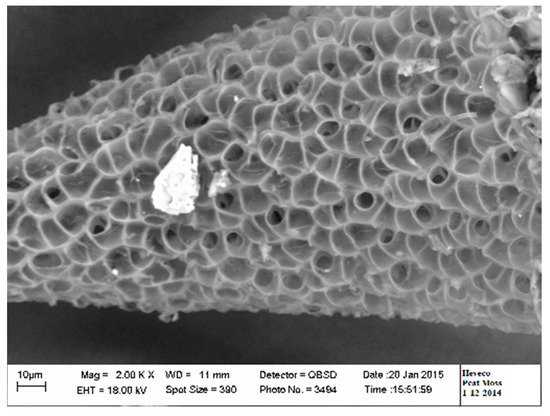2.1. Coir Based
Coir based growing media is one of the most widely used substrates for the production of medicinal cannabis in North America
[14]. The most common growing media for this category are: pure coir (loose), coir and perlite (loose), expandable coir blocks (various formulation of coir pith, fiber, and husk chips), preformed coir (blocks and pyramidal structures), grow bags and grow slabs.
Considered as a residue of the coconut industry, it is now widely used for the production of horticulture crops
[18]. The coir materials are available in various particle sizes ranging from fine particles, also called coir fiber or dust, to large fibrous material (2 cm to 10 cm long) of amorphous shapes and to chunks or various sizes. The main characteristic of coir materials is its hydrophilic property
[19] and having a tough structure. Coir has an excellent wettability and can rewet easily
[20][21], thus reducing the need for wetting agents. It also has a slow breakdown rate and therefore does not shrink during the growing production cycle. The aeration and drainage are usually high in coir products although it depends on their particle size distribution
[20][22]. Coir material usually holds a high volume of water
[21] because of its ability to absorb water. It has also a high aeration because of its particle size and structure. Coir products are seen as an alternative to rockwool products and an intermediate solution compared with peat-based products
[20][22][23]. Indeed, the aeration and the drainage are high enough for some products to manage irrigation in a similar way compared with rockwool. It is possible to practice several consecutive irrigation events and achieve a leaching point on a per event or day basis in a way similar to rockwool. Despite these similarities, there is a distinct difference between rockwool and coir production in terms of sustainability. Specifically, rockwool is not easily recyclable or reusable after use whereas coconut coir production is relatively sustainable.
Although these attributes make coir products popular, the material available on the market is variable and may cause some problems to inexperienced users
[24]. Particle size may vary from fine dust (1 to 4 mm) to large chunks, 1–4 cm in diameter. That makes a large array of products with variable physical properties available to users. The coir product can be compressed to a 5:1 ratio on a volume basis for example. Compressed products expand and gain their original volume easily when watered (15–19 L of water to hydrate a 5 kg block of coco coir, based on HortGrow
[25]). That property allows coir products to be offered in various sizes and shapes and reduce the volume when stored. Coconut pith, fiber, chunks and blends are offered as compressed bricks, slabs and various pre-shaped stabilized products. Stabilized products are available as rooting cubes, grow cubes of various sizes and shapes. Beside regular cubes, the pyramid grow unit is one the most unusual stabilized products found on the market.
Coir may have a high salts level if it is not washed or buffered. However, salts are relatively soluble and leachable in coir. Unwashed and unbuffered coir is usually rich in sodium, potassium and chloride and therefore may cause a risk of calcium and magnesium deficiency during a lag period. Coir also has a fairly high cation exchange capacity and therefore can help retain nutrients. The chemical structure and the high internal porosity of the fiber contribute to its high exchange capacity (
Figure 1). K, Na and Cl can be present in amounts detrimental to crop developments
[21]. These elements must be mitigated or replaced with more beneficial ones
[20][24]. A common manufacturer’s technique is to wash coir with fresh water to remove excess salts
[26]. The washing techniques are various such as leaving bulk material to open rainfall. The results are variable and users should test their products before use. A second well known technique in the industry is to use certain mineral salts, most commonly calcium salts, during washing to force the exchange of excess elements with more beneficial elements
[26]. The resulting product is said to be “buffered”. Buffering is a chemical process by which the excess sodium and potassium bound to the coir are replaced by calcium to help prevent calcium and magnesium deficiency during the growth cycle. A period of time is allowed for the exchange to take place, then leached and dried in the open air. The efficacy of buffering is variable among manufacturers and depends on the volume of water for leaching, the buffering salts used, and the time period allowed for cation exchange.
Figure 1. Scanning electron microscopic view of a coir particle.
Irrigation practices in the cannabis industry are widely varied. This is largely due to the clandestine background of cannabis production limiting scientifically led investigation into the best practices for cannabis production, as previously mentioned. One major factor relating to the frequency and duration of irrigation events is the volume of substrate that the plants are growing in, as well as the growing style employed. As an example, a grower may only have a large irrigation event once every 2 days because they are growing in a very large pot. Another grower may have a small substrate volume, requiring many irrigation events per day.
Unlike other crops grown in high intensity container based production, there are no agreed upon standards currently for the irrigation strategies in cannabis. This is beginning to change gradually, with a notable shift towards higher frequency irrigation strategies with a smaller volume of substrate. This is more in-line with traditionally grown crops such as greenhouse tomato, cucumber and pepper which have been grown in progressively smaller substrate volumes to reduce cost of production, as well as increase the controllability of the moisture content of the root zone.
One notable property of coir-based growing media is their high aeration
[20][22], as mentioned above. This helps to maximize the root zone of the crop, increasing root growth, which leads to increased water and nutrient uptake throughout the lifecycle of the crop. Cannabis is notoriously susceptible to root disease, and a lack of oxygen in the root zone is a strong contributing factor for the infection and spread of root pathogens. Coconut coir has a reputation for being difficult to overwater, and is associated with a reduced instance of disease. This has benefits for hobbyists and commercial growers alike. This, among the properties discussed has led to the increased adoption of coir-based growing media into the cannabis industry.
2.2. Rockwool
Rockwool is made from basalt rocks or other minerals which are liquefied at high temperature and then spun into fibers
[27]. Rockwool is another one of the soilless options for growing cannabis. It is considered to be an appropriate substrate due to its capabilities to provide moderate to good aeration
[21] and possessing excellent water holding capacity
[5]. Rockwool is available in multiple sizes and shapes for various applications: blocks, cubes and slabs
[28][29][30]. The use of rockwool as a growing medium has several advantages. It is a lightweight substrate with a bulk density of about 50–100 g/L
[31] and is easy to handle and to use. Rockwool is homogeneous, consistent and durable which means it does not readily break down and it keeps relatively consistent properties. Rockwool is usually free of phytopathogenic microorganisms due to use of heat to produce rockwool which renders it sterile and safe for growing plants. Because of this heat, rockwool is unlikely to contain naturally occurring beneficial microbial populations when first planted out. However, microbial life does develop in rockwool during the growth cycle of plants. Rockwool is considered as an inert material which means it neither reacts to nor changes the nutrient balance of the applied solution. It has low nutrient retention capacity (CEC about zero).
Rockwool exhibits 91 to 95% total porosity that can be occupied with water when saturated or with air when dried
[12][21]. It can hold more nutrient solution and air than any other growing medium. This air space makes oxygen, water and nutriment solution easily accessible to plant roots. Rockwool has a high air capacity and high ratio of easily available water (EAW). Rockwool has very low unavailable water (bounded water) and it drains well. It also has a uniform wetting. It promotes root growth, and provides even drainage.



